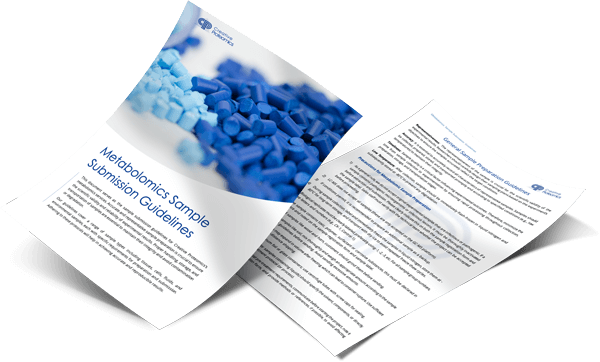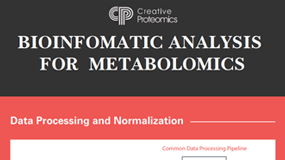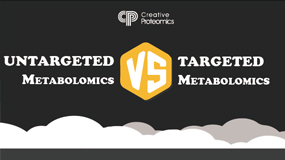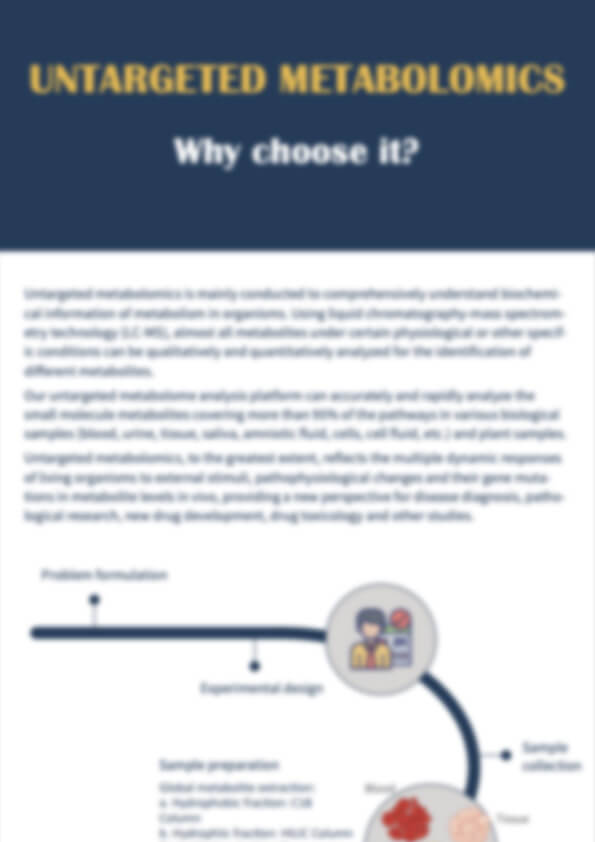Untargeted Metabolomics Service for Comprehensive Global Pathway Profiling
Discover the full picture of metabolism.
Creative Proteomics offers LC-MS and GC-MS Untargeted Metabolomics Services that provide a complete, unbiased profile of all detectable metabolites within a sample. Our global metabolomics platform identifies both known and unknown compounds, enabling researchers to map dynamic biochemical pathways and reveal hidden biomarkers.
We help you:
- Characterise global metabolic changes in health, disease, and environmental response.
- Gain discovery-driven insight for mechanism studies, drug research, and breeding projects.
- Obtain publication-ready datasets through our validated untargeted metabolomics workflow.
Start your global metabolomics project→
Submit Your Request Now
×- Untargeted vs Targeted
- Service Details
- Why Choose Us
- Applications
- Strategies & Challenges
- Demo
- Customer Case
- FAQ
What Is Untargeted Metabolomics?
Untargeted metabolomics—also called discovery metabolomics—uses high-resolution LC-MS or GC-MS to detect as many metabolites as possible without a predefined target list. It provides global metabolomic profiling that captures subtle biochemical shifts between experimental and control groups.
This approach supports:
- Biomarker discovery in clinical, agricultural, and microbial systems.
- Pathway elucidation for complex metabolic networks.
- Multi-omics integration, linking metabolites to genomic or proteomic data.
Untargeted analysis complements targeted workflows by revealing unexpected molecules that drive biological differences.
Recommended reading: Difference Between Targeted and Untargeted Metabolomics.
How to Choose: Untargeted vs Targeted vs Broad-Target Metabolomics
Decision Table: Choosing the Right Metabolomics Strategy
| Approach | Scope & Goal | Typical Coverage | Quantitation Level | Ideal Use Case |
|---|---|---|---|---|
| Untargeted Metabolomics | Capture all detectable metabolites without preset targets | Hundreds to thousands of metabolites | Relative (fold-change, intensity) | Exploratory studies (e.g., new biomarkers, mechanism discovery) |
| Targeted Metabolomics | Precisely measure a defined set of known metabolites | Dozens to ~100 metabolites | Absolute concentrations (with standards) | Validation studies, hypothesis-driven quantification |
| Broad-Target (Semi/"Wide") Metabolomics | Hybrid model bridging discovery + quantification | Hundreds of metabolites with partial standard coverage | Mixed (absolute where standards exist; relative otherwise) | When you need wider coverage than targeted yet better quant than simple untargeted |
Guidance for Service Buyers
- If you do not know exactly which metabolites you need and want to explore global metabolic changes, start with untargeted metabolomics.
- If you already have specific compounds of interest (for example in a drug-metabolism study or known biomarker panel) and require precise quantification, choose targeted metabolomics.
- If your project demands broad profiling plus the possibility of quantification for many analytes, opt for broad-target metabolomics—a cost-efficient middle ground.
- Many projects follow a two-phase strategy: begin with untargeted for discovery, then follow with targeted to validate top hits.
Key Considerations for Selection
- Analytical instrumentation: Untargeted platforms typically use high-resolution MS (Orbitrap/TOF), whereas targeted uses triple quadrupole (QqQ) systems.
- Database and standards: Targeted workflows require authentic chemical standards for each compound; untargeted relies more on libraries and putative IDs.
- Data complexity & analysis workload: Untargeted generates large datasets and unknowns requiring bioinformatics; targeted data is smaller and easier to interpret.
- Cost vs coverage trade-off: Targeted is higher cost per metabolite but high precision; untargeted gives breadth at lower cost per feature but less quant precision.
Our Discovery Metabolomics Service Package
Creative Proteomics delivers a full spectrum of untargeted metabolomics solutions that combine wide metabolite coverage with tailored analytical depth. Each module below is designed to address a specific biological question—from clinical biomarker discovery to plant or microbial metabolism profiling.
Service Contents
- Integrated Analytical Modules
- Technology Options
- Output Scope
- Customisation Pathways
Integrated Analytical Modules
Our platform is modular, allowing you to choose the most relevant matrix or research scenario:
Serum Metabolomics: Detect early metabolic disturbances and candidate biomarkers linked to disease or treatment effects.
Urine Metabolomics: Track non-invasive metabolic signatures of toxicity, nutrition, and drug metabolism.
Cerebrospinal Fluid Metabolomics: Investigate neurochemical pathways and metabolic shifts in neurological disorders.
Plant Untargeted Metabolomics: Characterise both primary and secondary metabolites that govern yield, quality, and stress tolerance.
Exosome Metabolomics: Reveal vesicle-derived molecules mediating intercellular communication.
Gut Flora Metabolomics: Explore metabolite exchange between host and microbiota.
Technology Options
LC–MS/MS Untargeted Metabolomics:
High-resolution profiling for semi-polar and non-volatile metabolites.
GC–MS Untargeted Metabolomics:
Optimal for volatile compounds and thermally stable intermediates.
Multi-platform Integration:
LC–MS + GC–MS data fusion for unified global metabolomics analysis.
Optional NMR support for confirmation of key metabolites.
Output Scope
- Relative quantification of hundreds to thousands of metabolites.
- Differential-expression statistics, PCA/PLS-DA clustering, and KEGG/Reactome pathway annotation.
- Optional cross-platform correlation between LC–MS and GC–MS datasets.
- Exportable results compatible with R-based bioinformatics pipelines or internal LIMS.
Customisation Pathways
- Add targeted quantification for confirmed hits or integrate with lipidomics/proteomics.
- Choose pilot-scale (≤ 20 samples) or large-cohort (> 200 samples) configurations.
- Request data-only delivery or full interpretation with figures, pathway maps and publication formatting.
Untargeted Metabolomics Conventional Analysis Workflow
A well-designed untargeted metabolomics workflow ensures reliable results and meaningful interpretation. At Creative Proteomics, we follow a systematic process—covering design, data acquisition, analysis, and interpretation—to support global metabolomic profiling.
1. Experimental Design & Sample Preparation
- Define biological groups, replicates, and study power upfront.
- Select appropriate sample type (e.g., serum, urine, tissue, cell extract) and matching storage/shipping conditions.
- Quench metabolic activity, extract metabolites with protein precipitation or liquid-liquid extraction, and preserve sample integrity.
- Include pooled QC samples to monitor system stability and reproducibility.
2. Metabolite Detection (LC–MS and/or GC–MS)
- Employ high-resolution MS systems (Orbitrap, TOF) supporting wide coverage of metabolites from hydrophilic to hydrophobic.
- Use dual-polarity ionisation (positive/negative) and chromatographic strategies (C18, HILIC or amide columns) to maximise metabolome breadth.
- Acquire full-scan MS1 data and MS/MS fragmentation for downstream annotation and structural insight.
3. Data Preprocessing & Feature Extraction
- Clean raw data by removing noise and background signals via de-convolution, baseline correction, retention time alignment, and feature extraction.
- Align features across samples, impute missing values (e.g., 80% rule), normalise for batch or ion suppression effects.
4. Statistical Screening of Differential Metabolites
- Conduct unsupervised multivariate analysis (e.g., PCA) to assess sample clustering, QC tightness and variance distribution.
- Apply supervised methods (PLS-DA, OPLS-DA) and univariate tests (t-test, ANOVA) to identify significant features (VIP > 1.0, p < 0.05).
- Visualise results via volcano plots, heatmaps, and hierarchical clustering to highlight group differences.
5. Metabolite Identification & Annotation
- Match detected m/z, retention time, adduct and MS/MS spectra against curated databases (HMDB, METLIN, mzCloud) to assign putative identities.
- Assign annotation confidence (e.g., MSI Level 1–4), flag unknowns for future validation.
6. Biological Interpretation & Pathway Mapping
- Map identified metabolites into biochemical pathways using KEGG, Reactome or MetaCyc to uncover mechanistic insights.
- Integrate metabolite changes with other omics (transcriptomics, proteomics) via network or correlation analysis to build systems-level understanding.
7. Reporting & Deliverables
- Provide a comprehensive report containing experimental design, QC summary, statistical results, annotated metabolite lists and pathway diagrams.
- Deliver raw data, processed feature matrix and visualisation files suitable for publication or further analysis.
 Figure 1. Workflow of untargeted metabolomics. Samples are processed through solvent extraction, LC–MS/MS dual-mode analysis, and rigorous QC evaluation. Statistical modelling and pathway enrichment deliver a comprehensive metabolite profile ready for biological interpretation.
Figure 1. Workflow of untargeted metabolomics. Samples are processed through solvent extraction, LC–MS/MS dual-mode analysis, and rigorous QC evaluation. Statistical modelling and pathway enrichment deliver a comprehensive metabolite profile ready for biological interpretation.
 Figure 2. Conceptual analytical logic of untargeted metabolomics.
Figure 2. Conceptual analytical logic of untargeted metabolomics.
The process begins with global LC–MS profiling, followed by statistical screening of differential metabolites. Functional enrichment and machine-learning-based biomarker discovery jointly reveal pathway mechanisms and candidate biomarkers for targeted validation.
Data Quality and Deliverables
High-quality data are the foundation of meaningful metabolomics interpretation. Creative Proteomics follows a controlled analytical framework to ensure every dataset meets the expectations of reproducibility, traceability, and publication-readiness.
Quality Control Framework
Our quality assurance begins at sample intake and continues through data reporting.
Instrument Calibration: Routine mass accuracy checks and retention-time correction ensure consistent system performance.
QC Sample Strategy:
- Pooled quality-control (QC) samples analysed every 5–10 injections to monitor drift.
- Internal standards added to each batch to track extraction and ionisation stability.
Reproducibility Metrics: Features with coefficient of variation (CV) ≤ 30 % in QC runs are retained for downstream analysis.
Blank & Carryover Checks: Solvent blanks inserted periodically to prevent contamination and false positives.
These measures allow us to provide datasets suitable for quantitative comparison across batches and projects.
Data Processing Standards
Peak Detection & Normalisation: Automated feature detection followed by signal correction against internal standards.
Missing Value Imputation: Applied only when justified by QC patterns; missingness > 20 % triggers re-analysis review.
Statistical Validation: Multivariate models cross-validated (R2, Q2) and permutation-tested to avoid over-fitting.
Annotation Confidence:
- Level 1: Confirmed by standard compound and MS2 match.
- Level 2–3: Putative identification by database and fragmentation pattern.
- Level 4: Unknown features documented for further study.
Deliverables
All projects include a structured data package optimised for downstream analysis and regulatory documentation.
Digital Outputs
- Raw instrument data (.raw, .wiff, or equivalent).
- Processed peak tables (m/z, retention time, intensity).
- Normalised and annotated feature matrix with metabolite IDs.
- Statistical analysis summary with PLS-DA, PCA, and volcano plot outputs.
Interpretive Materials
- Pathway enrichment tables and bubble plots based on KEGG/Reactome.
- QC performance charts and batch-correction reports.
- Optional multi-omics correlation modules linking metabolites to transcriptomic or proteomic data.

Recommended Reading:
For detailed QC concepts and reporting standards, see Untargeted Metabolomics Sample Processing & QC Guide and LC–MS Setup for Untargeted Metabolomics.
Why Choose Creative Proteomics for Global Metabolomics
At Creative Proteomics, we elevate global metabolomics from raw detection to actionable insight. Our service is built around four distinct pillars of value: coverage, technology, bioinformatics, and service reliability.
1. Unrivalled Metabolite Coverage & Depth
- We reliably detect 1,000+ metabolites across 12+ chemical classes using high-resolution platforms.
- Broad chemical space coverage (polar to non-polar, volatiles to lipids) ensures you won't miss key pathway signals.
- Supports wide sample types — from serum and urine to tissue, plants, exosomes and microbiome matrices.
2. State-of-the-Art Technical Platform
- We deploy high-resolution MS systems (e.g., Orbitrap Q Exactive HF-X, GC-TOF) with dual-polarity scanning and dual-column chromatography for full metabolome coverage.
- For volatile and semi-volatile metabolites we leverage GC-MS in tandem with LC-MS, giving you a unified global metabolomics workflow.
- Automated sample preparation and large throughput capacity support scalable studies (10,000+ samples per year) for CRO and academic demands.
3. Expert Bioinformatics and Pathway-Level Interpretation
- Our pipeline moves from feature extraction and multivariate statistics (PCA, PLS-DA) to pathway enrichment, network correlation, and biomarker ranking.
- Identification confidence is built into the workflow: MS1 + MS2 + retention time + curated databases support MSI Level 1–4 annotation.
- We provide visual, publication-ready deliverables: volcano plots, heatmaps, KEGG bubble diagrams, annotated metabolite lists.
4. Tailored Service, Reproducibility & CRO-Grade Quality
- We customise protocols based on your matrix and research goal (e.g., plant stress study, clinical biomarker discovery, microbiome metabolome).
- Rigorous QC: internal standards, pooled QCs, drift correction, batch control to deliver reproducible results you can trust.
- From early-phase discovery to targeted follow-up validation, we support your project across the full metabolomics lifecycle.
Database of Metabolites

Applications of Global Untargeted Metabolomics
Untargeted metabolomics delivers a panoramic view of biochemical activity, enabling researchers to connect metabolic phenotypes with genetic and environmental influences. Creative Proteomics applies this platform across diverse biological and industrial domains to uncover mechanisms, biomarkers, and functional pathways.







Biomedical and Pharmaceutical Research
Untargeted LC–MS metabolomics plays an essential role in human health studies.
- Disease Mechanism Discovery: Identify metabolic pathways disrupted in cancer, diabetes, cardiovascular, and neurodegenerative diseases.
- Biomarker Screening: Detect unknown metabolites that correlate with disease onset, drug toxicity, or therapeutic response.
- Drug Mechanism Profiling: Assess metabolic modulation induced by candidate compounds during early discovery and preclinical evaluation.
Neuroscience
- Cerebrospinal fluid (CSF) and plasma metabolomics offer a biochemical window into the central nervous system.
- Identify neurotransmitter and energy-related metabolites linked to Alzheimer's, Parkinson's, or depression.
- Support early diagnostic research by differentiating subtle metabolic signatures.
- Integrate with proteomic or transcriptomic datasets for pathway-level interpretation.
Plant and Agricultural Sciences
Plant metabolomics underpins modern crop improvement and secondary metabolite discovery.
- Profile primary metabolites that influence growth, flavour, and yield.
- Map secondary metabolites such as flavonoids, alkaloids, and terpenoids that drive stress adaptation and nutritional quality.
- Support breeding programs with quantitative trait metabolomics (QTM) data.
Microbiome and Environmental Research
Untargeted metabolomics reveals the small-molecule language of microbial ecosystems.
- Study gut microbiota–host interactions using stool or intestinal contents to identify metabolites influencing immunity or metabolism.
- Investigate fermentation processes and microbial communities in agriculture or food production.
- Characterise soil and environmental metabolomes to assess ecological health and pollutant impact.
Food Science and Nutritional Studies
- Optimise flavour, aroma, and shelf stability through comprehensive volatile and non-volatile profiling.
- Trace authenticity of natural products and detect adulteration using metabolic fingerprints.
- Correlate nutrient composition with sensory and health properties.
Industrial Biotechnology and Synthetic Biology
- Monitor cell factory performance and pathway flux during metabolic engineering.
- Support bio-based production of amino acids, lipids, and specialty chemicals through metabolome monitoring.
- Combine with isotope-labelled approaches for flux-omics analysis.
Integrated Omics and Systems Biology
Untargeted metabolomics forms a key layer within multi-omics frameworks.
- Correlate metabolite data with gene-expression and protein-abundance profiles.
- Construct metabolic networks that explain phenotype variation across populations or treatments.
- Facilitate data-driven modelling for precision agriculture, precision medicine, and synthetic design.
Global Metabolomics Strategies, Challenges, and Emerging Directions
As metabolomics technologies mature, researchers face new strategic decisions about study design, data integration, and computational interpretation.
Table: Strategic Overview of Global Untargeted Metabolomics
| Dimension | Current Strategies | Key Challenges | Emerging Directions |
|---|---|---|---|
| Analytical Platforms | Use of LC–MS and GC–MS hybrid workflows to capture both polar and volatile metabolites; expansion to UPLC–Orbitrap and Q Exactive HF-X systems for high mass accuracy. | Instrument variability, matrix effects, and incomplete metabolite ionisation reduce comparability across studies. | Multi-platform integration (LC–MS + GC–MS + NMR), miniaturised systems for single-cell or microfluidic metabolomics. |
| Coverage and Identification | Broad untargeted acquisition (DDA/DIA) combined with in-house and public libraries (HMDB, METLIN, mzCloud). | ~60 % of detected features remain unidentified; reference standards are limited or unavailable. | AI-driven spectral matching, in silico fragmentation, and retention-time prediction using machine learning to improve annotation rates. |
| Quantitation and Reproducibility | Relative quantification through peak intensities and internal standards; pooled QC for drift correction. | Batch effects and inter-lab variation affect reproducibility and data comparability. | Adoption of harmonised QC protocols, stable isotope-labelled universal internal standards, and cross-lab reference materials. |
| Data Processing and Analysis | Automated pipelines for feature detection and multivariate statistics (PCA, PLS-DA, KEGG mapping). | Inconsistent software parameters, feature redundancy, and annotation errors lead to variable outputs. | Cloud-based unified pipelines and FAIR-compliant data formats for reproducible computational workflows. |
| Multi-Omics Integration | Correlation analysis between metabolome and transcriptome/proteome datasets to interpret pathway activity. | Data scale imbalance and differing measurement units make integration difficult. | Development of cross-omics normalisation algorithms and graph-based network modelling to unify biological layers. |
| Applications and Translation | Biomarker discovery, crop breeding, microbial fermentation, and environmental metabolome monitoring. | Translating findings to validated, actionable biomarkers remains slow. | Expansion into precision medicine, digital twins of metabolism, and real-time metabolic monitoring using wearable biosensors. |
Key Takeaways
- The field is shifting from feature detection to mechanistic interpretation through improved annotation and pathway-level mapping.
- Integration with proteomics and transcriptomics now defines the next generation of global metabolomics analysis.
- AI-assisted curation and open databases will drive faster identification of unknown metabolites and increase the reproducibility of global maps metabolomics.
Sample Requirements
| Sample type | Recommended sample size | Pre-treatment and storage |
|---|---|---|
| Tissue | 100-200 mg | Snap freezing in liquid nitrogen, stored at -80℃. |
| Urine | 200-500 μL | 5000×g 4℃ Centrifuge for 30-60min, remove supernatant, store at -80℃. |
| Serum/plasma | >100 μL | Collected serum/plasma, snap freezing in liquid nitrogen, stored at -80℃. |
| Cerebrospinal fluid, amniotic fluid, bile and other body fluids | >200 μL | 4℃ Centrifuge for 10min, (or filter using 0.22μm membrane), remove supernatant and store at -80℃. |
| Suspension cells | >1*107 | Centrifuge and collect cells after liquid nitrogen snap freezing and store at -80℃. |
| Walled cells | >1*107 | Cultured walled cells are stored in 1.5ml centrifuge tubes, snap freezing in liquid nitrogen and stored at -80℃. |
| Cell supernatant | >2 mL | centrifuge at 4℃ for 3 minutes, take the supernatant and store at -80℃. |
Demo
Figures come from (Li, Y.et.al, Sci Rep,2023)
Customer Case Study
FAQ
What is untargeted metabolomics and how does it differ from targeted metabolomics?
Untargeted metabolomics (also called global metabolite profiling) surveys as many small-molecule metabolites as possible in a sample without prior selection of targets; by contrast, targeted metabolomics focuses on a predefined list of compounds for high-accuracy quantitation.
When should I choose an untargeted metabolomics service rather than targeted or semi-targeted analysis?
If your research goal is discovery of novel biomarkers, broad metabolic pathway screening, or understanding system-wide changes rather than quantifying a specific metabolite set, then untargeted workflows offer a comprehensive starting point; targeted or semi-targeted services follow when you have defined candidates.
What types of samples can be analysed using untargeted metabolomics?
Biofluids (serum, plasma, urine), tissues, plants, cells, exosomes and other matrices are suitable for untargeted metabolomics; the service supports diverse sample types for global metabolite profiling.
What are the main steps in an untargeted metabolomics workflow and what should I expect?
A typical workflow includes sample preparation and extraction, LC-MS/MS or GC-MS data acquisition (often in positive and negative ion modes), data preprocessing (peak alignment, normalisation, QC), statistical screening (PCA, PLS-DA, volcano plots), pathway enrichment and biological interpretation.
What are the key advantages and limitations of untargeted metabolomics?
Advantages include unbiased detection of thousands of metabolites, enabling hypothesis generation and pathway discovery; limitations include relative quantification (not always absolute concentrations), complex data analysis, and challenges in identifying unknown compounds.
How do I interpret the results and how can they support my research objectives?
Results include differential metabolite lists, statistical plots and pathway maps; these can be used for biomarker candidate selection, mechanistic insight, hypothesis generation and downstream targeted validation—helping researchers and CRO clients translate data into actionable insights.
Do I need to have prior knowledge of metabolites or pathways before starting an untargeted metabolomics project?
No. One of the strengths of untargeted metabolomics is that it does not require you to preset a target metabolite list or define hypotheses in detail; it is ideally suited when you seek a broad, global view of metabolic alterations.
How do you ensure data quality and reliability in untargeted metabolomics services?
Quality assurance includes use of QC sample sets, performance monitoring of chromatographic and mass-spectrometric systems, dual ionisation modes (+/–), replicate analysis where appropriate, and robust bioinformatics pipelines for preprocessing and statistical validation.
Learn about other Q&A about other technologies.
Publications
Here are some publications in Metabolomics research from our clients:

- Water-soluble saponins accumulate in drought-stressed switchgrass and may inhibit yeast growth during bioethanol production. 2022. https://doi.org/10.1186/s13068-022-02213-y
- Characterization of CYCLOPHILLIN38 shows that a photosynthesis-derived systemic signal controls lateral root emergence. 2021. https://doi.org/10.1093/plphys/kiaa032
- Macrophage-associated lipin-1 promotes β-oxidation in response to proresolving stimuli. 2020. https://doi.org/10.4049/immunohorizons.2000047
- Novakomyces olei sp. nov., the First Member of a Novel Taphrinomycotina Lineage. 2021. https://doi.org/10.3390/microorganisms9020301
- Elevated SLC7A2 expression is associated with an abnormal neuroinflammatory response and nitrosative stress in Huntington’s disease. 2024. https://doi.org/10.1186/s12974-024-03038-2
References
- Kind, T.; Wohlgemuth, G.; Lee, D. Y.; Lu, Y.; Palazoglu, M.; Shahbaz, S.; Fiehn, O., FiehnLib: Mass Spectral and Retention Index Libraries for Metabolomics Based on Quadrupole and Time-of-Flight Gas Chromatography/Mass Spectrometry. Anal. Chem. 2009, 81 (24), 10038-10048.
- McGlynn, D. F.; Yee, L. D.; Garraffo, H. M.; Geer, L. Y.; Mak, T. D.; Mirokhin, Y. A.; Tchekhovskoi, D. V.; Jen, C. N.; Goldstein, A. H.; Kearsley, A. J.; Stein, S. E., New Library-Based Methods for Nontargeted Compound Identification by GC-EI-MS. J. Am. Soc. Mass. Spectrom. 2025, 36 (2), 389-399.
- uo, J.; Qiu, M.; Li, L.; Gao, Z.; Zhou, G.; Liu, X., Comparative transcriptomic analysis and volatile compound characterization of Aspergillus tubingensis and Penicillium oxalicum during their infestation of Japonica rice. Food Microbiol. 2025, 125.
- Xie, Q.; Yuan, H.; Liu, S.; Liang, L.; Luo, J.; Wang, M.; Li, B.; Wang, W., Mid-Level Data Fusion Techniques of LC-MS and HS-GC-MS for Distinguishing Green and Ripe Forsythiae Fructus. Molecules 2025, 30 (7).




























